04.10.2019.
An urgent communication of the International Center of the Roerichs
THE UNIQUE ROERICH MONUMENT IN RUSSIA IS BEING DESTROYED
On 9 October 2019 the international community is celebrating 145th anniversary of Nicholas Roerich, one of the greatest Russian 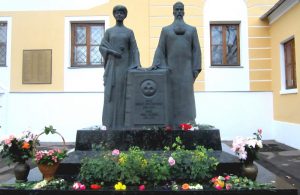 painters, who was also a thinker and public figure of world renown. Many countries are organizing exhibitions, conferences and other cultural events dedicated to this commemorative date.
painters, who was also a thinker and public figure of world renown. Many countries are organizing exhibitions, conferences and other cultural events dedicated to this commemorative date.
On the eve of this anniversary within the meeting of the Valdai club President of the Russian Federation Vladimir Putin mentioned the merits of our outstanding compatriot. Vladimir Putin underlined that “In Russia the bright colors of the East have always inspired our writers, poets, artists and musicians. I am talking about Pushkin, Rimsky-Korsakov, Arsenyev, Vereshchagin, Kandinsky and Roerich. The Russian audience as well as foreign knows these names”. It is true. In India Nicholas Roerich’s artistic legacy is highly appreciated, his beautiful paintings are considered national heritage. On the occasion of the artist’s anniversary, a memorial bust of Nicholas Roerich will be unveiled in the Himalayan estate in Kullu, where Nicholas Roerich spent the last 20 years of his life. This ceremony is a tribute that the Indian nation pays to the prominent artist.
However, Russian officials of the Ministry of Culture and members of the State Museum of Oriental Art (SMOA) have decided to celebrate Nicholas Roerich’s anniversary in their own way. On the eve of 3 October 2019, Director General of the State Museum of Oriental Art Mr. Sedov firmly demanded that the International Center of the Roerichs dismantle the Roerichs monument located in the territory of the Lopukhins’ estate (Moscow) within 5 days, where it was unveiled in 1999, 20 years ago, in the presence of the Foreign Policy Adviser to the President Mr. Vorontsov and Minister of Moscow City Government Mr. Norkin.
The height of cynicism is that the destruction of the Roerichs memorial containing ashes of Nicholas Roerich is organized namely in the conjunction with his anniversary (9 October). Together with the memorial the officials insist on dismantling of busts of Nicholas Roerich’s sons Yuri, who was an orientalist of world renown, and Svetoslav, an outstanding artist and public figure, who donated his parents’ heritage to their Motherland.
It is known that the Roerichs memorial was installed within the territory of the Lopukhins’ estate in accordance with Svetoslav Roerich’s will. In fact, it was one of the conditions for transferring the Roerichs’ heritage to Russia. Besides, he set forward two more conditions, namely to establish the non-governmental Museum named after Nicholas Roerich and locate it in the Lopukhins’ estate. The Russian Government fulfilled these conditions and respected them until Mr. Medinsky was appointed the Minister of Culture and started a war against the Roerichs.
In April 2017 the non-governmental Museum named after Nicholas Roerich was illegally seized and completely destroyed. The Ministry of Culture demanding to demolish the Roerichs monument is thus making a new step to clear anything reminding of this outstanding family from Moscow city center.
However, the Roerichs monument was created only with non-governmental funds. Thousands of people from different countries and cities collected donations to fulfil Svetoslav Roerich’s will and install the monument dedicated to his outstanding father in the Lopukhins’ estate. Today, the State Museum of Oriental Art which broke the equipment and display of the non-governmental Museum named after Nicholas Roerich and seized the Roerichs’ heritage with impunity and the silent consent of the administration of the Ministry of Culture, is going to destroy the monument containing the artist’s ashes.
We call on Russian and foreign community and the admirers of Nicholas Roerich! If you respect this prominent figure, do not let anyone treat the memory of Nicholas Roerich and his family with disrespect! It is necessary that everyone raise the voice against immoral actions of the Russian officials of the Ministry of Culture!
Press Office of the International Center of the Roerichs

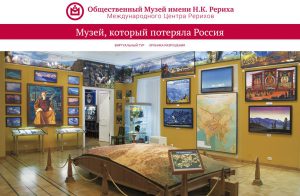
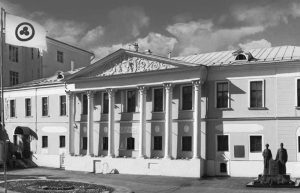
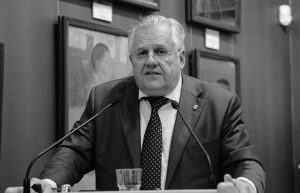
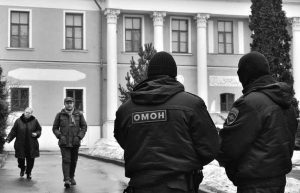
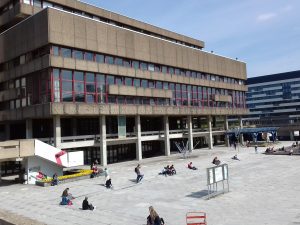
 Frau Dr. Lapp, Direktorin der Universitätsbibliothek richtete ein Grußwort an die Gäste. In ihren Ausführungen dankte sie den Organisatoren der Ausstellung und führte historische Momente im Zusammenhang mit der Unterzeichnung des Roerich-Paktes am 15. April 1935 in Washington aus. Sie äußerte ihre Überzeugung über die Wichtigkeit der Durchführung von Maßnahmen, die dazu dienen, sich aktiv der Fragen zum Schutz der gesamten kulturellen Errungenschaften der Menschheit anzunehmen. Bedauerlicherweise würden aber der Roerich-Pakt und auch die Haager Konvention von 1954 häufig missachtet, auch in Europa. Auf jeden Fall müssen die Kulturgüter auch in Friedenszeiten geschützt und geschätzt werden. Und mit dieser Ausstellung würden das ICR und die Deutsche Roerich-Gesellschaft aktiv die uns alle angehenden Aufgaben verdeutlichen. Frau Dr. Lapp äußerte ihre Freude darüber, dass die Ausstellung in den lebendigen Räumen einer Bibliothek durchgeführt wird, denn hier verbrächten die Studenten einen nicht geringen Teil ihres Hochschullebens.
Frau Dr. Lapp, Direktorin der Universitätsbibliothek richtete ein Grußwort an die Gäste. In ihren Ausführungen dankte sie den Organisatoren der Ausstellung und führte historische Momente im Zusammenhang mit der Unterzeichnung des Roerich-Paktes am 15. April 1935 in Washington aus. Sie äußerte ihre Überzeugung über die Wichtigkeit der Durchführung von Maßnahmen, die dazu dienen, sich aktiv der Fragen zum Schutz der gesamten kulturellen Errungenschaften der Menschheit anzunehmen. Bedauerlicherweise würden aber der Roerich-Pakt und auch die Haager Konvention von 1954 häufig missachtet, auch in Europa. Auf jeden Fall müssen die Kulturgüter auch in Friedenszeiten geschützt und geschätzt werden. Und mit dieser Ausstellung würden das ICR und die Deutsche Roerich-Gesellschaft aktiv die uns alle angehenden Aufgaben verdeutlichen. Frau Dr. Lapp äußerte ihre Freude darüber, dass die Ausstellung in den lebendigen Räumen einer Bibliothek durchgeführt wird, denn hier verbrächten die Studenten einen nicht geringen Teil ihres Hochschullebens.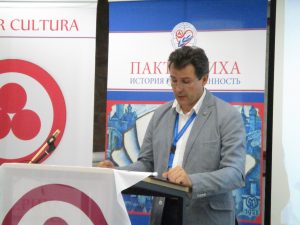 Seitens des Internationalen Roerich-Zentrums richtete Eduard Tomsha, Vorstandsmitglied des ICR und Vorsitzender der Sankt Petersburger Zweigniederlassung des ICR, sein Grußwort an die Gäste. In seiner Ansprache wies Eduard Tomsha darauf hin, dass eine solche Ausstellung dazu geeignet ist, die Kräfte der internationalen Öffentlichkeit bei der Wahrung von Kultur und Frieden auf der Grundlage der wichtigsten Antikriegsidee Nikolaj Roerichs – “Frieden durch Kultur” – zu konsolidieren.
Seitens des Internationalen Roerich-Zentrums richtete Eduard Tomsha, Vorstandsmitglied des ICR und Vorsitzender der Sankt Petersburger Zweigniederlassung des ICR, sein Grußwort an die Gäste. In seiner Ansprache wies Eduard Tomsha darauf hin, dass eine solche Ausstellung dazu geeignet ist, die Kräfte der internationalen Öffentlichkeit bei der Wahrung von Kultur und Frieden auf der Grundlage der wichtigsten Antikriegsidee Nikolaj Roerichs – “Frieden durch Kultur” – zu konsolidieren.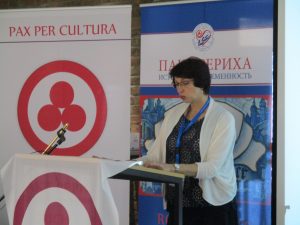 Halina Schneider, Vorstandsvorsitzende der Deutschen Roerich-Gesellschaft, gab während ihres Grußwortes eine kurze Einführung in die aktuelle Ausstellung und ihre Themen. Hervorzuheben ist das für diese Ausstellung erstmalige Konzept einer separaten Website (www.roerichpakt.com) mit einer “virtuellen Führung durch die Ausstellung”, bei der mit Hilfe von QR-Codes dem Besucher nähere Informationen und Hintergründe zu den einzelnen Themenbereichen und Bildern Nikolaj Roerichs gegeben werden.
Halina Schneider, Vorstandsvorsitzende der Deutschen Roerich-Gesellschaft, gab während ihres Grußwortes eine kurze Einführung in die aktuelle Ausstellung und ihre Themen. Hervorzuheben ist das für diese Ausstellung erstmalige Konzept einer separaten Website (www.roerichpakt.com) mit einer “virtuellen Führung durch die Ausstellung”, bei der mit Hilfe von QR-Codes dem Besucher nähere Informationen und Hintergründe zu den einzelnen Themenbereichen und Bildern Nikolaj Roerichs gegeben werden.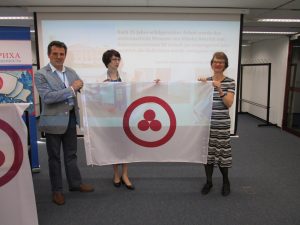 Zum Abschluss der Eröffnung des Ausstellungsprojektes wurde traditionell das Friedensbanner an die Hausherrin übergeben. Abgerundet wurde die Eröffnung mit einem geführten Rundgang durch die Ausstellung.
Zum Abschluss der Eröffnung des Ausstellungsprojektes wurde traditionell das Friedensbanner an die Hausherrin übergeben. Abgerundet wurde die Eröffnung mit einem geführten Rundgang durch die Ausstellung. 2018 ist das Europäische Kulturjahr. Und auch in diesem Jahr findet das Internationale Ausstellungsprojekt “Der Roerich-Pakt. Geschichte und Gegenwart” in Deutschland seine Fortsetzung.
2018 ist das Europäische Kulturjahr. Und auch in diesem Jahr findet das Internationale Ausstellungsprojekt “Der Roerich-Pakt. Geschichte und Gegenwart” in Deutschland seine Fortsetzung.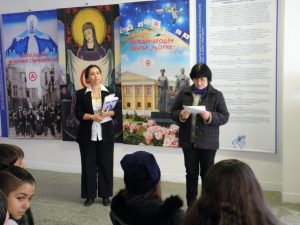
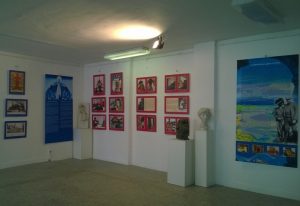
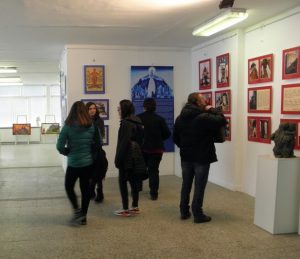
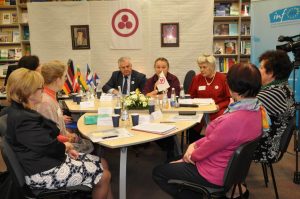 THE GRAND opening ceremony took place in the foyer, where an exhibition dedicated to the creation and signing of the Roerich Pact was launched. Evgeniya Dynko has performed “Prelude in C-dur” by Bach and “Waltz” by Georgy Sviridov. Marianna Ozolina, the Chairperson of the Latvian Branch of the ICR has greeted the participants of the meeting and addressed the words of gratitude to the Baltic International Academy. She has noted that the Banner of Peace, a symbol of the Roerich Pact, has a direct link to the venue of the round table. The building in which the round table was to be held a quarter of a century ago was one of the blocks of Riga Institute of Civil Aviation Engineers. An astronaut Talgat Musabaev was among the graduates of this institute. It was Talgat Musabaev who hoisted in outer space the Banner of Peace, handed to him by the Vice-President of the ICR Lyudmila Shaposhnikova.
THE GRAND opening ceremony took place in the foyer, where an exhibition dedicated to the creation and signing of the Roerich Pact was launched. Evgeniya Dynko has performed “Prelude in C-dur” by Bach and “Waltz” by Georgy Sviridov. Marianna Ozolina, the Chairperson of the Latvian Branch of the ICR has greeted the participants of the meeting and addressed the words of gratitude to the Baltic International Academy. She has noted that the Banner of Peace, a symbol of the Roerich Pact, has a direct link to the venue of the round table. The building in which the round table was to be held a quarter of a century ago was one of the blocks of Riga Institute of Civil Aviation Engineers. An astronaut Talgat Musabaev was among the graduates of this institute. It was Talgat Musabaev who hoisted in outer space the Banner of Peace, handed to him by the Vice-President of the ICR Lyudmila Shaposhnikova.